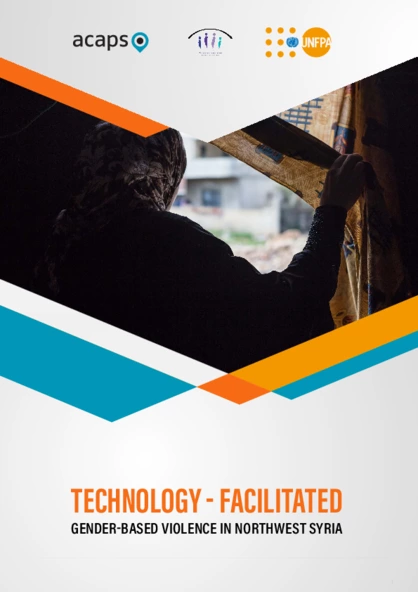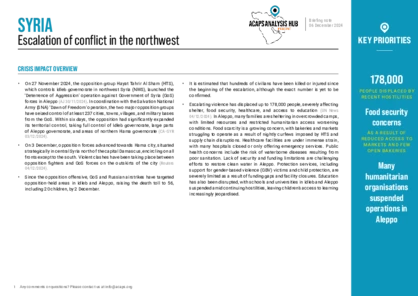Latest updates on country situation
21 October 2025
Between 15 August and 15 October 2025, a total of 108 explosive ordnance incidents resulted in 158 casualties — 39 deaths and 119 injuries — across Syria, notably in Aleppo, Dar'a, Deir Al Zor, and Homs governorates. Most incidents occurred in agricultural and grazing zones, with men and children particularly affected. Restricted access to trauma and rehabilitation services is increasing long-term risks, underscoring the urgent need for clearance operations, risk education, and medical assistance. (MA AoR 15/10/2025, HI13/10/2025)
02 September 2025
By 28 August 2025, intensified hostilities since mid-July had displaced 187,000 people from Al Sweida. Most remain within the governorate, while others have fled to Dar’a and Rural Damascus. Displacement has disrupted access to services, leaving families in urgent need of shelter, food, water, healthcare, and protection amid access constraints. (UNICEF 29/08/2025, OCHA 29/08/2025)
01 September 2025
Syria is experiencing its worst drought in decades, with rainfall at just 25% of seasonal norms. Over 16.2 million people need humanitarian assistance, including more than ten million urgently requiring WASH support. In Damascus, water levels in the Ein Al Fijeh Spring have dropped to historic lows, cutting piped supply to under two hours daily for three million residents. Rural Damascus faces similar conditions, with the Barada River’s near disappearance leaving 1.2 million underserved. In Homs, well failures and groundwater depletion affect 1.5 million people, while Al Sweida reports consumption below survival thresholds. In Deir Al Zor and Raqqa, conflict-damaged systems have collapsed under drought pressures, while communities in Aleppo, Al Hasakeh, and Dar’a rely on costly water trucking. Livelihoods are deteriorating, with drought affecting over 75% of crops, reducing wheat production by 40%. Rising fodder prices have reduced livestock numbers by 40%, deepening food insecurity and eroding coping capacities. (IFRC 30/08/2025, Reuters 18/08/2025)
23 July 2025
Clashes between Druze and Bedouin militias in Al Sweida governorate displaced nearly 93,000 people between 11–20 July 2025. The clashes also killed at least 1,300, including civilians, armed men, and Syrian forces. Most people have been displaced within Al Sweida, while others have gone to Dar’a and Rural Damascus governorates. IDPs are staying with relatives or in public buildings such as schools and mosques, and they need shelter, ready-to-eat meals, clean water, and medical care.
(SOHR 23/07/2025, UNHCR 21/07/2025, SARI Global 22/07/2025)
16 July 2025
Between 13–16 July 2025, violent clashes following the abduction of a Druze merchant by Bedouin armed men erupted between Druze militias and Bedouin fighters in southern Al Sweida governorate, killing at least 200 people and injuring an unknown number. By 14 July, the clashes had displaced at least 300 families, or an estimated 1,700 people, mostly to Salkhad city with host families. The displaced urgently need protection, medical care, and shelter. Power outages, road closures, and a citywide curfew are hindering humanitarian access. (BBC 16/07/2025, Al Araby 14/07/2025, SARI Global 15/07/2025)
09 July 2025
High temperatures, prolonged drought, and strong winds have been causing widespread wildfires since 30 June, primarily impacting Latakia governorate, as well as Homs and Tartous. At least 25,000 people have been affected, with over 2,000 evacuated to nearby villages or Latakia City to stay with host families. Immediate needs include medical supplies, mobile clinics, water tanks, emergency food, and safe drinking water. By 8 July, the continuous fires had destroyed at least 180 km² of land, killed livestock, and destroyed crops and olive groves. Electricity and water pumping services have been disrupted, with the Al Basit power station damaged. The presence of unexploded ordnance and remnants of war hinders firefighting efforts. This marks the fifth consecutive year of wildfires in Latakia, with this crisis recorded as the worst following Syria's most severe drought in 36 years. The fires' impact on agriculture is expected to worsen food insecurity, with 9.1 million people already experiencing acute food insecurity in 2025. (SARC 08/07/2025, OCHA 07/07/2025, FAO 01/07/2025)
25 June 2025
On 16 June 2025, Israeli forces demolished about 15 civilian homes in Al Hamidiyah village in the countryside of Al Quneitra governorate as part of their regular incursions into southern Syria to establish military posts. The move displaced an estimated 85 people to nearby villages, some of which also reported loss of agricultural land, increasing needs for shelter and livelihoods. (SNHR 21/06/2025, Enab Baladi 20/06/2025, ETANA 23/05/2025)
current crises
in
Syria
These crises have been identified through the INFORM Severity Index, a tool for measuring and comparing the severity of humanitarian crises globally.
SYR003 - Complex crisis
Last updated 27/11/2025
Drivers
Conflict/ Violence
Political/economic crisis
Drought/drier conditions
Crisis level
Country
Severity level
4.5 Very High
Access constraints
4.0
Active risks
Analysis products
on
Syria
22 July 2025
Syria: risk analysis - escalating sectarian tensions and humanitarian implications (July–December 2025)
DOCUMENT / PDF / 1,004 KB
This report presents a forward-looking analysis of the potential rise in sectarian and social tensions in Syria throughout 2025, along with related conflict dynamics.
Attached resources
03 June 2025
Syria: Technology-facilitated gender based violence in the northwest
DOCUMENT / PDF / 1 MB
Technology-facilitated gender-based violence (TFGBV) is a widespread and rapidly growing concern across Northwest Syria (NWS). TFGBV is driven by limited digital literacy, the accumulated effects of protracted conflict, and entrenched conservative gender norms, resulting in the weaponisation of the Internet and significant shame and victim blaming.
06 January 2025
Syria: humanitarian impact overview (October–December 2024)
DOCUMENT / PDF / 2 MB
The Syria humanitarian impact overview is a quarterly publication that provides decision makers with a short, accessible overview of key trends and emerging challenges with the potential to affect humanitarian needs in Syria.
Attached resources
06 December 2024
Syria: escalation of conflict in the northwest
DOCUMENT / PDF / 445 KB
On 27 November 2024, the opposition group Hayat Tahrir Al Sham, launched an operation against Government of Syria in Aleppo. Within six days, the opposition had significantly expanded its territorial control. It is estimated that hundreds of civilians have been killed or injured. Escalating violence has displaced up to 178,000 people, severely affecting shelter, food security, healthcare, and access to education.
29 September 2023
Syria: Capacity-strengthening needs in NWS non-government-controlled areas
DOCUMENT / PDF / 290 KB
This report explores the capacity-strengthening needs of the local NGOs (LNGOs) headquartered and registered in Türkiye and the local responders operating in the nongovernment- controlled areas of Northwest Syria (NWS) – Idleb and northern Aleppo – following the February 2023 earthquake response and the July 2023 non-renewal of the UNSC cross-border resolution. The capacity-strengthening needs are categorised based on the three strategic pillars of the Humanitarian Leadership Academy (HLA).






